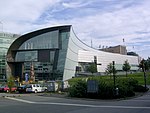VR warehouses
2006 in FinlandBuildings and structures demolished in 2006Buildings and structures in HelsinkiDemolished buildings and structures in FinlandKluuvi ... and 1 more
Warehouses

The VR warehouses (Finnish: VR:n makasiinit) were a group of redbrick railway warehouses designed by Bruno Granholm in the centre of Helsinki, Finland. They were used by the Finnish State Railways from their construction in 1899 until the 1980s. Their official address was Mannerheimintie 13. The warehouses were badly damaged in a fire on 5 May 2006 and were subsequently demolished. The Helsinki Music Centre was built on the site of the warehouses.
Excerpt from the Wikipedia article VR warehouses (License: CC BY-SA 3.0, Authors, Images).VR warehouses
Kansalaistori, Helsinki City Centre (Southern major district)
Geographical coordinates (GPS) Address Website Nearby Places Show on map
Geographical coordinates (GPS)
| Latitude | Longitude |
|---|---|
| N 60.17305 ° | E 24.935566666667 ° |
Address
Laulupuut
Kansalaistori
00099 Helsinki, City Centre (Southern major district)
Finland
Open on Google Maps









